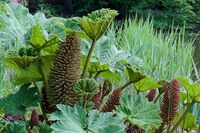Gunnera Cyanobacteria symbiosis
Gunnera

Gunnera is the only genus in the family Gunneraceae. Gunnera, consisting of about 30-40 species, is a herbaceous flowering plant found in Central and South America, Africa, Madagascar, Tasmania, New Zealand and Hawaii [1].
Gunnera manicata is one of the largest species of Gunnera native to the Serra do Mar mountains of southeastern Brazil. Leaves range from 1.5 to 2.0 meters long [2] with an average diameter of 2.5m. Some leaves have been measured to be up to 3.3m across when cultivated [3]. In contrast, Gunnera albocarpa is a species of Gunnera found in New Zealand that has leaves that measure only l-2cm long Gunnera albocarpa [4] .
Cyanobacteria
Cyanobacteria are the largest phylum of Gram-positive prokaryotes on earth dating back to 3.5 billion years ago[5]. They evolved the ability to use photosynthesis to obtain their energy, making them different from other single celled organisms at the time [6]. By photosynthesizing, the Cyanobacteria produce oxygen as a byproduct. This is believed to have both helpe the bacteria successfully prosper because the environment in which they were developing was otherwise occupied by anaerobic bacteria and cause the Great Oxidation Event [7]. The Great Oxidation Event is where the earth first experiences a rise in the amount of oxygen in the atmosphere and oceans[8].
Many species of Cyanobacteria live in large colonies of cells ranging from hundreds to thousands of cells in a single colony [9]. These colonies are able to form filaments, sheets, or hollow spheres [10]. When too large, they can form harmful algal blooms that can cause great harm to the aquatic ecosystem and the surrounding area it lives [11]. Cyanobacteria can be found in almost any terrestrial or aquatic environment ranging from oceans and lakes to extremes like wet rocks in a desert or in the Antarctic [12]
Cyanobacteria are wide spread around the world, contributing to major global biogeochemical cycles like cellular death [13]. They also have been shown to be responsible for a large portion of the earth’s N2 and CO2 fixation. N2 fixation is a process where the Cyanobacteria can convert the nitrogen gas into ammonia, nitrites, and nitrates which can then be used by plants to make proteins and nucleic acids[14]. In CO2 fixation, Cyanobacteria have large proteins called carboxysomes which have been seen to take up inorganic carbon and efficiently “fix” it into organic compounds that can then be used by living organisms[15].
Gunnera and Cyanobacteria symbiosis
Include some current research, with a second image.
Conclusion
Overall text length (all text sections) should be at least 1,000 words (before counting references), with at least 2 images.
Include at least 5 references under References section.
References
- ↑ Gunneraceae: gunnera. Phylogeny of New Zealand Plants. (n.d.). Retrieved November 24, 2021, from https://plantphylogeny.landcareresearch.co.nz/webforms/viewtree.aspx?ObjectID=e6155e0d-5659-4813-86f7-70a5f1c250ca.
- ↑ Gunnera Explained. (n.d.). Retrieved November 24, 2021, from http://everything.explained.today/Gunnera/.
- ↑ BBC. (2011, October 14). Abbotsbury Gardens celebrates plant's 'monster' leaves. BBC News. Retrieved November 24, 2021, from https://www.bbc.com/news/uk-england-berkshire-15308919
- ↑ Gunnera albocarpa. Alpine Garden Society. (n.d.). Retrieved November 24, 2021, from http://encyclopaedia.alpinegardensociety.net/plants/Gunnera/albocarpa.
- ↑ Schopf, J. W., & Packer, B. M. (1987). Early Archean (3.3-billion to 3.5-billion-year-old) microfossils from Warrawoona Group, Australia. Science, 237(4810), 70-73.
- ↑ Sinha, R. P., & Häder, D. P. (2008). UV-protectants in cyanobacteria. Plant Science, 174(3), 278-289.
- ↑ Whitton, B. A. (Ed.). (2012). Ecology of cyanobacteria II: their diversity in space and time. Springer Science & Business Media.
- ↑ Lyons, T. W., Reinhard, C. T., & Planavsky, N. J. (2014). The rise of oxygen in Earth’s early ocean and atmosphere. Nature, 506(7488), 307-315.
- ↑ Tamulonis, C., Postma, M., & Kaandorp, J. (2011). Modeling filamentous cyanobacteria reveals the advantages of long and fast trichomes for optimizing light exposure. PLoS One, 6(7), e22084.
- ↑ Aguilera, A., Klemenčič, M., Sueldo, D. J., Rzymski, P., Giannuzzi, L., & Martin, M. V. (2021). Cell death in Cyanobacteria: current understanding and recommendations for a consensus on its nomenclature. Frontiers in Microbiology, 12, 416.
- ↑ Paerl, H. W., & Otten, T. G. (2013). Harmful cyanobacterial blooms: causes, consequences, and controls. Microbial ecology, 65(4), 995-1010.(Pearl and Otten)
- ↑ De Los Ríos, A., Grube, M., Sancho, L. G., & Ascaso, C. (2007). Ultrastructural and genetic characteristics of endolithic cyanobacterial biofilms colonizing Antarctic granite rocks. FEMS microbiology ecology, 59(2), 386-395.
- ↑ Aguilera, A., Klemenčič, M., Sueldo, D. J., Rzymski, P., Giannuzzi, L., & Martin, M. V. (2021). Cell death in Cyanobacteria: current understanding and recommendations for a consensus on its nomenclature. Frontiers in Microbiology, 12, 416.
- ↑ Adams, D. G., & Duggan, P. S. (2008). Cyanobacteria–bryophyte symbioses. Journal of Experimental Botany, 59(5), 1047-1058.
- ↑ Hill, N. C., Tay, J. W., Altus, S., Bortz, D. M., & Cameron, J. C. (2020). Life cycle of a cyanobacterial carboxysome. Science advances, 6(19), eaba1269.
Edited by Rachael Tomasko, student of Joan Slonczewski for BIOL 116 Information in Living Systems, 2021, Kenyon College.
